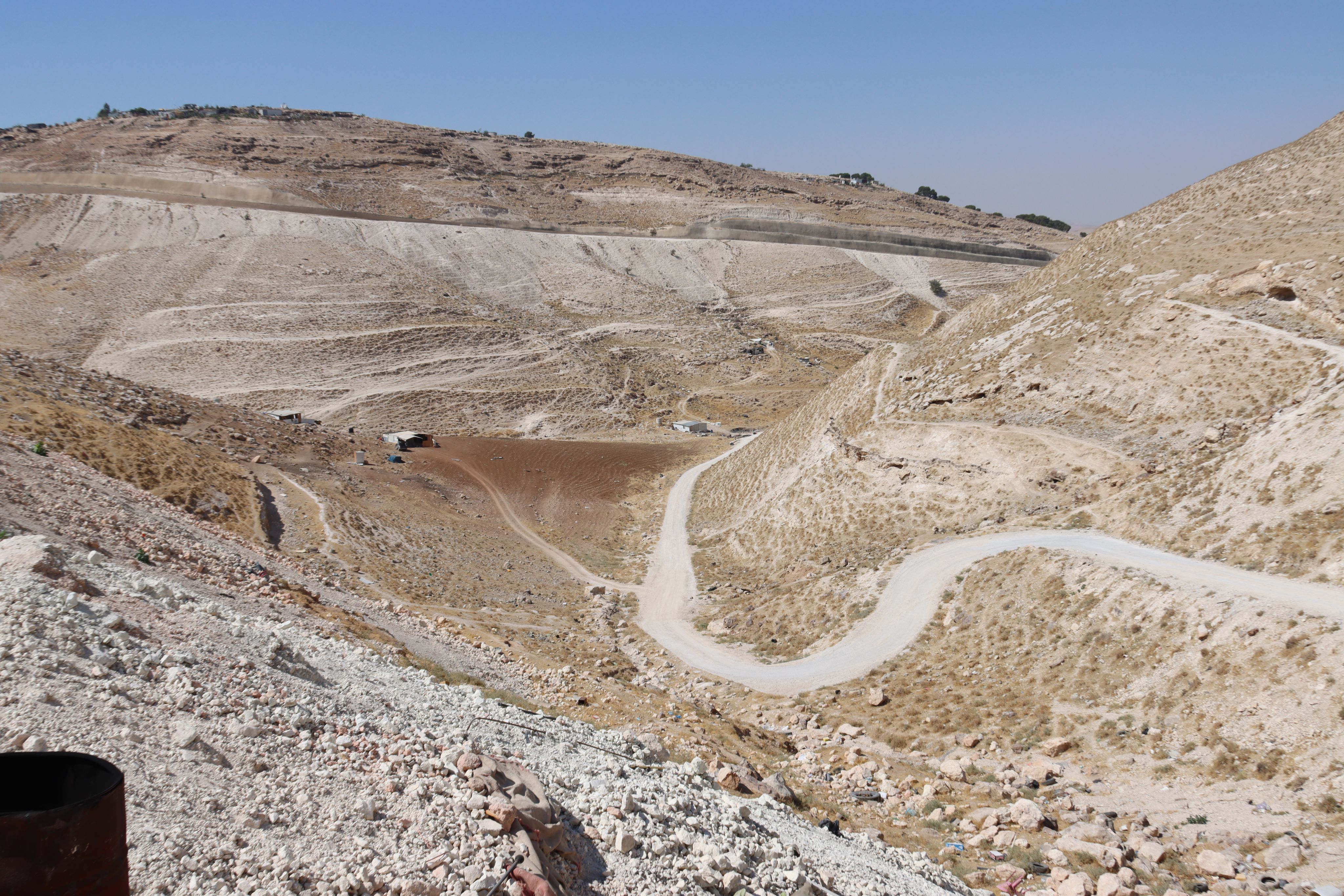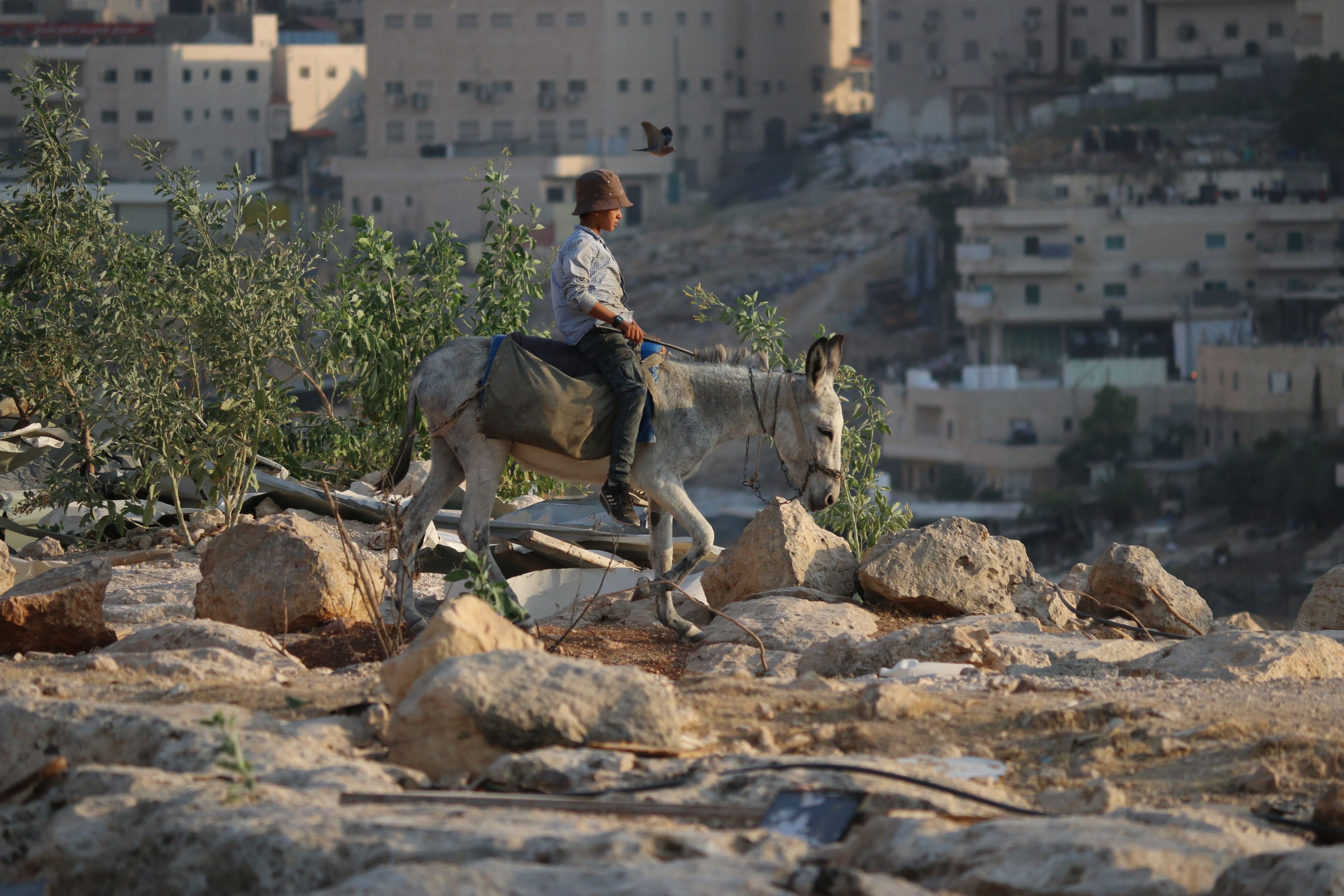In the West Bank, segregated roads displace Palestinians

Mousa Saray’a, 32, first received a demolition notice for his home more than seven years ago.
It wasn't until March 2021, however, that he got the call he had been dreading: Israeli surveyors were taking measurements right next to his home.
He left work, at a gas station in the nearby town of Al-Eizariya, and rushed home.
“I immediately went to check out what was happening and found out they were putting marks around our residences,” says Saray’a, who lives with his wife and four children in the West Bank Palestinian community of Arab Al-Saray’a, just east of Jerusalem.
“It is a very concerning situation. I expect the whole community will be demolished.”
Israeli authorities want to build a new road through the small village, which would result in the forcible transfer of all of its residents.
Israel wants to build a road that would displace Palestinian families.
Where everything is about geopolitics
On the surface, the threat of demolition in Arab Al-Saray’a might sound similar to the types of problems created by urban sprawl anywhere else in the world. But in the occupied Palestinian territory, and in the Jerusalem area in particular, geopolitics loom large over even the smallest of roadworks.
For decades, Israel has declared its intention to build settlements in an area just east of Jerusalem, referred to in planning documents as “E1”. Doing so would completely surround East Jerusalem with settlements and preclude meaningful geographic contiguity between the northern and southern West Bank. In addition, such settlements are illegal under international law.
For these reasons, E1 has been a major point of contention between Israel and the international community, which sees the project as a final blow to prospects of a two-state solution.
Any Palestinian presence in E1, both those living there and even Palestinian traffic passing through, poses a major obstacle to Israel’s settlement plans. However, Palestinians travelling between the northern and southern West Bank must currently use a highway that traverses the so-called E1 area.
Israeli authorities, therefore, are working toward “eliminating the need for Palestinians to travel through E1,” according to Amy Cohen, director of international relations and advocacy at Ir Amim, an Israeli organisation that focuses on Jerusalem within the context of the Palestinian-Israeli issue.
“The road project lays the groundwork for the future annexation steps of the area of E1,” she adds.
Meet a community at the heart of the conflict.
‘Fabric of life’ roads: Segregation toward annexation
In a critical step toward achieving that reality, in March 2020, the Israeli Ministry of Defence approved a plan to create a new “fabric of life” road for Palestinians that diverts traffic around E1.
“Fabric of life” is a term used by the Israeli authorities to refer to highways and roads that divert Palestinian traffic away from Israeli settlers. By contrast, roads that divert settlers away from Palestinians towns and cities are referred to as “bypass” roads.
The new “fabric of life” road in the E1 area would connect the towns of Az-Za’ayyem in the north with Al-Eizariya in the south, fully bypassing the Ma’ale Adumim settlement bloc. Only Israelis and those with special Israeli military permits would be allowed to continue using the current north-south thoroughfare.
At its northern end, the new Palestinian-designated road would connect to another recently opened north-south pathway. The road is so glaringly segregated – with a concrete barrier running down the middle to separate Palestinian and Israeli traffic – that it has been dubbed “the apartheid road.”
In mid-April 2021, Israeli bulldozers were about to start levelling land for the new road project, but a legal petition filed by an NRC-assigned lawyer succeeded in freezing the work.

A Palestinian house in the West Bank community of Jabal Al-Baba (foreground), with the Israeli settlement of Ma'ale Adumim pictured in the background.
A Palestinian house in the West Bank community of Jabal Al-Baba (foreground), with the Israeli settlement of Ma'ale Adumim pictured in the background.
“Catastrophic” traffic jams
In his previous role as defence minister, Israeli Prime Minister Naftali Bennett called the E1 infrastructure project a “sovereignty road” because it effectively connects Jerusalem to Ma’ale Adumim, thereby making it easier to annex the latter.
Attempting to downplay the negative impact on Palestinians, Israel claims that separating Palestinian and Israeli cars in the area would ease traffic. Experts disagree.
According to a recent technical report written for NRC by professor of civil engineering Samir Abu Aisheh:
“The Israeli military leadership’s claim that the road will facilitate Palestinians’ travel has no relation to reality."
The traffic jam will be “catastrophic,” he writes, because the road will feed even more vehicles into the already overloaded roads in Al-Eizariya.
The five-kilometre road will have only two lanes and will “force Palestinians to use it” as the only passage between the northern and southern West Bank.
Abu Aisheh stresses that the new road will increase travel times and traffic, not reduce them.

The area where Israel plans to establish a road solely for Palestinian traffic.
The area where Israel plans to establish a road solely for Palestinian traffic.
“It will be a very curvy road. Drivers will not be able to drive at a speed higher than 30-40 kilometres per hour.”
The new road project will also seize around 270 hectares of land that are part of the master plan for the Palestinian town of Al-Eizariya and limit the town’s ability to expand.

A Palestinian boy rides his donkey in Jabal Al-Baba community.
A Palestinian boy rides his donkey in Jabal Al-Baba community.
Displacing refugees for a second time
As planned, the new road would pass through an entire Palestinian refugee community, Arab Al-Saray’a, and displace all of its residents. The community consists of 30 people: Palestinian refugees and the descendants of refugees who were expelled from the areas that became Israel in 1948.
In the broader E1 area, some 3,000 Palestinians – also refugees – are at risk of a second forcible displacement, or in some cases, a third.
“This area is full of people who are already refugees from the Negev,” says Ali Sayayla, a representative of Wadi Al Jimel Bedouin community, also in E1. For decades, they lived on the land that is now part of the Ma’ale Adumim settlement bloc.
With the arrival of settlers in the mid-1990s, Sayayla says, “Israel started displacing us again”.
Israel wants to displace these communities so it can build more settlements and annex the territory. Israeli military authorities claim the Palestinian communities do not have the requisite permits to live there.
Settlement infrastructure at the expense of Palestinians
The E1 “sovereignty road” is not the only infrastructure project that serves settlements at the expense of Palestinians.
“In order to connect settlements to the main part of Israel at present, you need road infrastructure,” says Amy Cohen of Ir Amim. “Israel is expanding its territorial contiguity by building infrastructure to connect Israeli settlers to Israel proper, while providing Palestinians with the minimum connectivity to move between their locales.”
Hundreds of millions of dollars are being spent to expand walled-off and segregated roads that allow Israeli settlers to bypass Palestinian cities like Bethlehem, Huwara, and various refugee camps in the West Bank.
If implemented, these plans amount to “greater Israeli integration and continuity at the expense of greater Palestinian disintegration and fragmentation of the space,” says Cohen.


